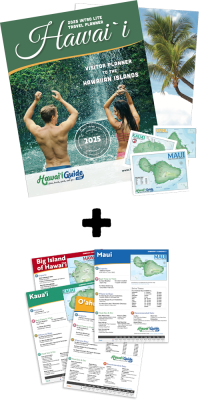Hawai'i is English speaking, though it is the only state with two official languages, English and Hawaiian. The Hawaiian language is a dialect of the Polynesian tongue, other variations of which are spoken by Samoans, Tahitians, Marquesans, Tuamotuans and Maoris.
Although Hawaiian, formerly a major means of communication, is all but extinct, it remains in place names, street names, songs, and the local residents liberally sprinkle their speech with words and phrases from the traditional language. A "pidgin" English has also formed throughout the state in varying degrees of richness, while some of the older immigrants from Japan and China continue to speak their native tongues.
The Hawaiian alphabet has only 12 letters: A, E, I, O, U, H, K, L, M, N, P, and W.
Vowel pronunciation:
A as in father, E as in vein, I as "ee" in peep, O as in own, and U as "oo" in boo.
Consonant pronunciation:
H as in hale, K as in Kate, L as in laid, M as in moon, N as in noon, P as in peak, and W as in always.
Rules of the Language:
Every word must end in a vowel. Every consonant must be followed by at least one vowel. Every syllable must end in a vowel.
The okina ( ' ) is a glottal stop like the sound between the ohs in "oh-oh" and is considered a consonant. In order to clarify pronunciation, you will often see the glottal stop or 'okina used on words in this guide such as Hawai'i. Due to printing restrictions, we will not use the macron, which is found above stressed vowels in the Hawaiian language.

Hawaii Shaka Gesture
The Skaka
Finally, we want to tell you about a very popular hand gesture in Hawaii, and no it's not the one you're probably used to back home. In Hawai'i when someone gives you the shaka sign (done by extending the pinkie and thumb while curling the middle fingers as seen here to the right) it's a sign of greeting, thanks, or just to say "Hey." Its origins are said to date to the 1930's.
FREE 2025 DOWNLOADS
Hawaii Intro Visitor Guide
+ Our Summary Guidesheets!
Includes the top must-see & do attractions, best times to visit, a monthly weather & visitor summary, and our tips on how to save when booking your car rental, tours, and activities. Plus, grab our free Hawaii Summary Guidesheets.



